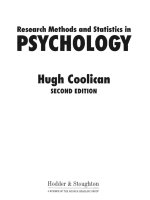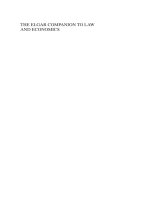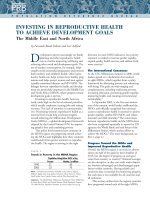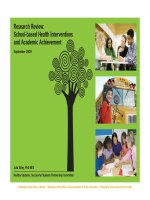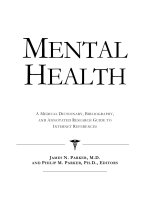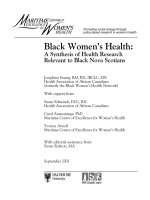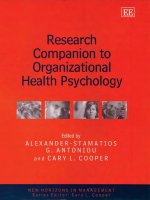RESEARCH COMPANION TO ORGANIZATIONAL HEALTH PSYCHOLOGY ppt
Bạn đang xem bản rút gọn của tài liệu. Xem và tải ngay bản đầy đủ của tài liệu tại đây (4.6 MB, 715 trang )
RESEARCH COMPANION TO ORGANIZATIONAL
HEALTH PSYCHOLOGY
NEW HORIZONS IN MANAGEMENT
Series Editor: Cary L. Cooper, CBE, Professor of Organizational Psychology and Health,
Lancaster University Management School, Lancaster University, UK
This important series makes a significant contribution to the development of manage-
ment thought. This field has expanded dramatically in recent years and the series provides
an invaluable forum for the publication of high quality work in management science,
human resource management, organisational behaviour, marketing, management infor-
mation systems, operations management, business ethics, strategic management and
international management.
The main emphasis of the series is on the development and application of new original
ideas. International in its approach, it will include some of the best theoretical and empir-
ical work from both well-established researchers and the new generation of scholars.
Titles in the series include:
The Handbook of Human Resource Management Policies and Practices in Asia-Pacific
Economics
Volume One
Michael Zanko
The Handbook of Human Resource Management Policies and Practices in Asia-Pacific
Economics
Volume Two
Michael Zanko and Matt Ngui
Human Nature and Organization Theory
On the Economic Approach to Institutional Organization
Sigmund Wagner-Tsukamoto
Organizational Relationships in the Networking Age
Edited by Willem Koot, Peter Leisink and Paul Verweel
Research Companion to
Organizational Health Psychology
Edited by
Alexander-Stamatios G. Antoniou
Consultant in the Department of Occupational and Industrial Hygiene,
National School of Public Health, Athens, and Research Centre of
Psychophysiology and Education, University of Athens, Greece
and
Cary L. Cooper, CBE
Professor of Organizational Psychology and Health, Lancaster University
Management School, Lancaster University, UK
New Horizons in Management
Edward Elgar
Cheltenham, UK • Northampton, MA, USA
© Alexander-Stamatios G. Antoniou and Cary L. Cooper 2005
All rights reserved. No part of this publication may be reproduced, stored in a retrieval system or
transmitted in any form or by any means, electronic, mechanical or photocopying, recording, or
otherwise without the prior permission of the publisher.
Published by
Edward Elgar Publishing Limited
Glensanda House
Montpellier Parade
Cheltenham
Glos GL50 1UA
UK
Edward Elgar Publishing, Inc.
136 West Street
Suite 202
Northampton
Massachusetts 01060
USA
A catalogue record for this book
is available from the British Library
ISBN 1 84376 624 8 (cased)
Printed and Bound in Great Britain by MPG Books Ltd, Bodmin, Cornwall
Contents
List of contributors ix
Foreword xiv
Preface xvi
PART I CONCEPTUALIZATION AND THEORETICAL FRAMEWORK
1 The role of event characteristics and situational appraisals in the prediction
of employee adjustment to change and change implementation success 3
Nerina L. Jimmieson
2 Constructions of occupational stress: nuisances, nuances or novelties? 20
Dianna Kenny and Dennis McIntyre
3 Psychosocial risk factors and work-related stress: state of the art and issues
for future research 59
Michiel A.J. Kompier and Toon W. Taris
4 Biological basis of stress-related diseases 70
Maria-Alexandra Magiakou and George P. Chrousos
5 The relationship between ethnicity and work stress 87
Grace V.F. Miller and Cheryl J. Travers
6 Eustress and attitudes at work: a positive approach 102
Debra L. Nelson and Bret L. Simmons
7 Stress and strain at work: how much is there, who has most and are things
changing? 111
Roy L. Payne
8 Stress, alienation and shared leadership 122
Marc J. Schabracq
9Job demands, job control, strain and learning behavior: review and research
agenda 132
Toon W. Taris and Michiel A.J. Kompier
10 The seeds of stress in the organizations of tomorrow: the impact of new
technology and working methods 151
Ashley Weinberg
PART II STRESS MANAGEMENT ISSUES
11 Stress and individual differences: implications for stress management 163
Susan Cartwright and Lynne C. Whatmore
v
12 Work-related stress: the risk management paradigm 174
Stavroula Leka, Amanda Griffiths and Tom Cox
13 Coping with stress through reason 188
Edwin A. Locke
14 An organizational approach to stress management 198
Valerie J. Sutherland
15 Prevention perspectives in occupational health psychology 209
Lois E. Tetrick, James Campbell Quick and Jonathan D. Quick
16 Emotional intelligence and coping with occupational stress 218
Moshe Zeidner
PART III STRESS IN SPECIFIC GROUPS
17 Study and student counselling in higher education: an incentive towards a
practice-relevant vision 243
Eric Depreeuw
18 Stress and unemployment: a comparative review of female and male
managers 254
Sandra L. Fielden and Marilyn J. Davidson
19 Stress in veterinary surgeons: a review and pilot study 293
Howard Kahn and Camilla V.J. Nutter
20 Structural work change and health: studies of long spells of sick leave and
hospitalization among working men and women during a period of marked
changes in the Swedish labour market 304
Gabriel Oxenstierna, Hugo Westerlund, Jane Ferrie, Martin Hyde,
Jan Hagberg and Töres Theorell
21 Role-related stress experienced by temporary employees 314
Ellen I. Shupe
PART IV STRESS, WELL-BEING AND HEALTH
22 The role of psychosocial factors in the development of periodontal disease 335
Alexander-Stamatios G. Antoniou, Diamanto Komboli, John Vrotsos and
Zacharias Mantzavinos
23 Work–family conflict and stress 346
Paula Brough and Michael O’Driscoll
24 Workaholism in organizations: work and well-being consequences 366
Ronald J. Burke
25 The healthy organization 382
Jane Henry
vi Contents
26 Health care and subjective well-being in nations 393
Bruce Kirkcaldy, Adrian Furnham and Ruut Veenhoven
27 New technology, the global economy and organizational environments:
effects on employee stress, health and well-being 413
Janice Langan-Fox
28 The effects of effort–reward imbalance at work on health 430
Johannes Siegrist, Bianca Falck and Ljiljana Joksimovic
29 Occupational stress and health 441
Charles D. Spielberger and Eric C. Reheiser
30 The role of emotions in cardiovascular disorders 455
Juan José Miguel-Tobal and Héctor González-Ordi
31 The impact of short business travels on the individual, the family and the
organization 478
Mina Westman
PART V PROFESSIONAL BURNOUT
32 Burnout and emotions: an underresearched issue in search of a theory 495
Dirk Enzmann
33 Proactive coping, resources and burnout: implications for occupational stress 503
Esther R. Greenglass
34 Burnout and wornout: concepts and data from a national survey 516
Lennart Hallsten
35 ‘Burning in’ – ‘burning out’ in public: aspects of the burnout process in
community-based psychiatric services 537
Thomas Hyphantis and Venetsanos Mavreas
36 A mediation model of job burnout 544
Michael P. Leiter and Christina Maslach
37 Love and work: the relationships between their unconscious choices and
burnout 565
Ayala Malach Pines
38 Unconscious influences on the choice of a career and their relationship to
burnout: a psychoanalytic existential approach 579
Ayala Malach Pines
39 Does burnout affect physical health? A review of the evidence 599
Arie Shirom and Samuel Melamed
40 Rediscovering meaning and purpose at work: the transpersonal psychology
background of a burnout prevention programme 623
Dirk van Dierendonck, Bert Garssen and Adriaan Visser
Contents vii
PART VI EMOTIONAL INTELLIGENCE AT WORK
41 Emotional intelligence and transformational leadership 633
Alexander-Stamatios G. Antoniou
42 Developing leadership through emotional intelligence 656
Richard E. Boyatzis
Index 671
viii Contents
Contributors
Alexander-Stamatios G. Antoniou,Research Centre of Psychophysiology and Education,
University of Athens, and Department of Occupational and Industrial Hygiene, National
School of Public Health, Athens, Greece
Richard E. Boyatzis,Professor of Organizational Behavior, Weatherheard School of
Management, Case Western Reserve University, USA
Paula Brough, Lecturer, School of Applied Psychology, Griffith University, Australia
Ronald J. Burke,Professor of Organisational Behaviour/Industrial Relations, Schulich
School of Business, York University, Canada
Susan Cartwright, Senior Lecturer in Organisational Psychology, Manchester School of
Management, UMIST, UK
George Chrousos, First Department of Pediatrics, Athens University Medical School and
Pediatric and Reproductive Endocrinology Branch, Bethesda, USA
Cary L. Cooper, CBE, Professor of Organizational Psychology and Health, Lancaster
University Management School, Lancaster University, UK
Tom Cox,Professor, Institute of Work, Health and Organisations, University of
Nottingham, UK
Marilyn J. Davidson,Professor of Managerial Psychology, Manchester School of
Management, UMIST, UK
Eric Depreeuw,Professor, Research Center for Motivation and Time Perspective, Catholic
University Brussels, Belgium
Dirk Enzmann, Institute of Criminal Sciences, Department of Criminology, University of
Hamburg
Bianca Falck, Department of Medical Sociology, University of Dusseldorf, Germany
Jane Ferrie, Senior Research Fellow, Department of Epidemiology and Public Health,
University College London, UK
Sandra L. Fielden, Lecturer in Organizational Psychology, Centre for Diversity and Work
Psychology, Manchester School of Management, UMIST, UK
ix
Adrian Furnham,Professor of Psychology, Department of Psychology, University
College London, UK
Bert Garssen, Helen Dowling Institute, Utrecht, The Netherlands
Héctor González-Ordi,Faculty of Psychology, Complutense University of Madrid, Spain
Esther R. Greenglass,Professor of Psychology, Department of Psychology, York
University, Canada
Amanda Griffiths,Professor of Occupational Health Psychology, Institute of Work,
Health and Organisations, University of Nottingham, UK
Jan Hagberg, Department of Statistics, Stockholm University, Stockholm, Sweden
Lennart Hallsten, Assistant Professor, National Institute for Working Life, Stockholm,
Sweden
Jane Henry, Chair of Creativity, Innovation and Change Programme, Open University,
Milton Keynes, UK
Martin Hyde, Department of Epidemiology and Public Health, University College,
London, UK
Thomas Hyphantis, Assistant Professor of Psychiatry, University of Ioannina Medical
School, Ioannina, Greece
Nerina L. Jimmieson, School of Psychology, University of Queensland, Australia
Ljiljana Joksimovic, Department of Medical Sociology, University of Dusseldorf,
Germany
Howard Kahn, Senior Lecturer, School of Management, Heriot-Watt University, UK
Dianna Kenny, Associate Professor, School of Behavioural and Community Health
Sciences, The University of Sydney, Australia
Bruce Kirkcaldy,Professor, International Centre for the Study of Occupational and
Mental Health, Düsseldorf, Germany
Diamanto Komboli, Associate Professor, Department of Periodontology, School of
Dentistry, University of Athens, Greece
Michiel A.J. Kompier,Professor, Department of Work and Organisational Psychology,
University of Nijmegen, The Netherlands
x Contributors
Janice Langan-Fox, Department of Psychology, University of Melbourne, Australia
Michael P. Leiter, Centre for Organizational Research and Devlopment, Acadia
University, Canada
Stavroula Leka, Institute of Work, Health and Organisations, University of Nottingham,
UK
Edwin A. Locke, Dean’s Professor (Emeritus) of Leadership and Motivation, R.H. Smith
School of Business at the University of Maryland, College Park, USA
Maria-Alexandra Magiakou, Assistant Professor of Pediatric Endrocrinology, University
of Athens, Greece
Ayala Malach Pines,Professor, Ben-Gurion University of the Negev, Israel
Zacharias Mantzavinos, Department of Periodontology, School of Dentistry, University
of Athens, Greece
Christina Maslach, Department of Psychology, University of California, Berkeley, USA
Venetsanos Mavreas, Assistant Professor of Psychiatry, University of Ioannina Medical
School, Ioannina, Greece
Dennis McIntyre, School of Behavioural and Community Health Sciences, The
University of Sydney, Australia
Samuel Melamed, Bar Ilian University, Israel
Juan José Miguel-Tobal,Professor, Faculty of Psychology, Complutense University of
Madrid, Spain
Grace V.F. Miller, The Business School, University of Loughborough, UK
Debra L. Nelson, Department of Management, Oklahoma State University, USA
Camilla V.J. Nutter, Heriot-Watt University, UK
Michael O’Driscoll,Professor of Psychology, Department of Psychology, Waikato
University, New Zealand
Gabriel Oxenstierna,National Institute for Psychosocial Medicine, Stockholm, Sweden
and Division for Psychosocial Factors and Health, Department of Public Health
Sciences, Karolinska Institutet, Stockholm, Sweden
Contributors xi
Roy L. Payne,Professor, Institute of Work Psychology, Sheffield University, UK
James Campbell Quick,Professor of Organizational Behaviour, Department of
Management, University of Texas at Arlington, USA
Jonathan D. Quick,World Health Organisation
Eric C. Reheiser, Center for Research in Behavioral Medicine and Health Psychology,
University of South Florida, Tampa, USA
Marc J. Schabracq, Independent Management Consultant and Department of Work and
Organization Psychology, University of Amsterdam, The Netherlands
Arie Shirom,Professor, The Leon Racanti Graduate School of Business Administration,
Tel Aviv University, Israel
Ellen I. Shupe, Assistant Professor, Department of Psychology, Grand Valley State
University, USA
Johannes Siegrist,Professor and Director, Department of Medical Sociology, University
of Dusseldorf, Germany
Bret L. Simmons, Assistant Professor, Department of Management, College of Business
Administration, North Dakota State University, USA
Charles Spielberger,Professor, Center for Research in Behavioral Medicine and Health
Psychology, University of South Florida, Tampa, USA
Valerie J. Sutherland, Business Psychology Research Unit, UMIST, UK
Toon W. Taris, Department of Work and Organizational Psychology, University of
Nijmegen, The Netherlands
Lois E. Tetrick,Professor and Director of Industrial Organizational Training,
Department of Psychology, University of Houston, USA
Töres Theorell,Professor, National Institute for Psychosocial Medicine, Stockholm,
Sweden and Division for Psychosocial Factors and Health, Department of Public Health
Sciences, Karolinska Institutet, Stockholm, Sweden
Cheryl J. Travers, The Business School, University of Loughborough, UK
Dirk van Dierendonck, Assistant Professor, University of Amsterdam, The Netherlands
xii Contributors
Ruut Veenhoven,Professor of Social Conditions for Human Happiness, Department of
Social Sciences, Erasmus University Rotterdam, and Professor of Humanism, University
of Utrecht, The Netherlands
Adriaan Visser, Helen Dowling Institute, Utrecht, The Netherlands
John Vrotsos,Professor, Department of Periodontology, School of Dentistry, University
of Athens, Greece
Ashley Weinberg, Senior Lecturer in Psychology, School of Community, Health Sciences
and Social Care, Salford University, UK
Hugo Westerlund,National Institute for Psychosocial Medicine, Stockholm, Sweden and
Division for Psychosocial Factors and Health, Department of Public Health Sciences,
Karolinska Institutet, Stockholm, Sweden
Mina Westman,Faculty of Management, Tel Aviv University, Israel
Lynne C. Whatmore, Manchester School of Management, UMIST, UK
Moshe Zeidner,Professor, University of Haifa, Israel
Contributors xiii
Foreword
There is ample scientific evidence that working (and other organizational) life and its con-
ditions are powerful determinants of health, for better or for worse. The relationship
works both ways. Work affects health but health, more often than not, also affects a
person’s productivity and earning capacity as well as his or her social and family rela-
tionships. Needless to say, this holds true for all aspects of health, both physical and
mental (Levi, 2002).
The many causes and consequences of work-related and other organizational expo-
sures are widespread in the 15 European Union member states. Over half of the EU’s 160
million workers report working at very high speeds (56 per cent), and to tight deadlines
(60 per cent). More than a third have no influence on task order. Forty per cent report
having monotonous tasks. Such work-related ‘stressors’ are likely to have contributed to
the present spectrum of ill health: 15 per cent of the workforce complain of headaches,
23 per cent of neck and shoulder pains, 23 per cent of fatigue, 28 per cent of ‘stress’, and
33 per cent of backache (European Foundation, 2001), plus a host of other illnesses,
including life-threatening ones, such as depressive disorders. Such disorders are the fourth
biggest cause of the global disease burden.
It is further likely that sustained work-related stress is an important determinant of
metabolic syndrome (Folkow, 2001; Björntorp, 2001), probably contributing to ischaemic
heart disease and Diabetes Type 2 morbidity.
In these ways, virtually every aspect of work-related health and disease can be affected.
Such influences can also be mediated through emotional, and/or cognitive misinterpreta-
tion of work conditions as threatening, even when they are not, and/or trivial symptoms
and signs occurring in one’s own body as manifestations of serious illness. All this can
lead to a wide variety of disorders, diseases, loss of well-being – and loss of productivity.
According to the European Union’s Framework Directive, employers have a ‘duty to
ensure the safety and health of workers in every aspect related to the work’. The
Directive’s principles of prevention include ‘avoiding risks’, ‘combating the risks at
source’, and ‘adapting the work to the individual’. In addition, the Directive indicates the
employers’ duty to develop ‘a coherent overall prevention policy’.
The short- and long-term outcomes of such interventions then need to be evaluated, in
terms of (a) stressor exposures, (b) stress reactions, (c) incidence and prevalence of ill
health, (d) indicators of wellbeing, and (e) productivity with regard to the quality and
quantity of goods or services. Also to be considered are (f) the costs and benefits in eco-
nomic terms. If the interventions have no effects, or negative ones in one or more respects,
the stakeholders may wish to rethink what should be done, how, when, by whom and for
whom. If, on the other hand, outcomes are generally positive, they may wish to continue
or expand their efforts along similar lines. It simply means systematic learning from expe-
rience. If they do so over a longer perspective, the workplace becomes an example of orga-
nizational learning (Levi and Levi, 2000).
To be cost-effective, such learning should be based both on a conceptual framework
xiv
and on empirical evidence. In addition, its possible impact should be evaluated across
societal sectors and scientific disciplines. This is why this volume has an important role to
play, as a basis for research but also for implementation and evaluation of the results of
such research.
This volume’s 42 theoretical and empirical chapters are grouped into six parts covering
conceptualization, theoretical framework, stress management, stress in specific groups,
stress as related to health and well-being, professional burnout and emotional intelligence.
The 72 distinguished contributors from over 50 different institutions provide a multi-
faceted picture of an important area mainly to an academic and post-graduate student
audience of Psychology and Medicine. I am pleased to recommend it for perusal, imple-
mentation and evaluation.
Lennart Levi, M.D., Ph.D.
November 2003
Emeritus Professor of Psychosocial Medicine
Karolinska Institutet
Stockholm, Sweden
References
Björntorp, P. (2001), ‘Heart and Soul: Stress and the Metabolic Syndrome’, Scandinavian Cardiovascular
Journal, 35, 172–77.
European Foundation, P. Paoli and D. Merllié (2001), Third European Survey on Working Conditions, Dublin:
European Foundation.
Folkow, B. (2001), ‘Mental Stress and its Importance for Cardiovascular Disorders; Physiological Aspects,
“from-mice-to-man”’, Scandinavian Cardiovascular Journal, 35, 165–72.
Levi, L. (2002), ‘The European Commission’s Guidance on Work-Related Stress: From Words to Action’, TUTB
Newsletter, 19–20, 12–17.
Levi, L. and I. Levi (2000), Guidance on Work-Related Stress. Spice of Life, or Kiss of Death?, Luxembourg:
Office for Official Publications of the European Communities.
Foreword xv
Preface
For slaves, there is no leisure, (Aristotle, Politics, 1334a 21)
The rapid change in the economy and technology along with the strong competition
worldwide has changed the way that we perceive the world and, consequently our life style.
Working hours are becoming longer and technological changes taking place every day
demand high levels of adaptability and flexibility. Jobs are no longer for life and the
modern family has been transformed from a one to a two-earner structure, creating a sit-
uation where individuals are expected to balance work and home commitments. The ques-
tion which arises at this point is: who shall survive this process? One could answer it is the
‘fittest’ employee who has the ability to adjust adequately to these rapid changes and can
remain undistracted from external factors. Furthermore such a person manages to avoid
the experience or to cope with the negative effects of stress.
Organizational health psychology has its share in contributing to the understanding of
healthy behaviours within working environments and identifying parameters that can be
the cause of health problems. For example, stress in the workplace can contribute to indi-
vidual and organizational skill effectiveness but it is also an aspect which, in most cases,
leads to undesirable effects. In general, organizational stress is by definition an unpleas-
ant state of being that affects employees’ creativity and work pleasure, while its results on
physical and psychological well-being are evident. The undesirable effects of job-related
stress occur when this acts as a barrier to employees’ adjustment to the work setting. In
addition to the impact of occupational stress on the individual’s well-being, the conse-
quences for organizations are particularly important: poor individual functioning, com-
pensation claims, accidents, absenteeism, medical expenses and the reduction of
workplace satisfaction and productivity. These are some of the most important factors
which relate to workplace stress and affect the workers’ psychosomatic status as well as
the organizations in terms of productivity and effectiveness.
Although organizational stress constitutes only one of the major topics in the field of
organizational health psychology, the need to raise awareness of this problem is empha-
sized worldwide with the aim of adopting direct measures to protect employees’ hygiene
and safety and advance their mental health cost-effectively for organizations. With the
pressures of the competitive world market on working standards, workers are subjected
to heavy workloads and pressing schedules. The recent redesigning of the traditional work
structure is the cause of an increase in work rates, a boost in productivity, ‘downsizing’,
underpromotion and job insecurity. Nevertheless individuals are expected to respond to
these demanding and ever changing conditions in a positive and creative way.
The Greek philosopher Aristotle, in his acclaimed work Politics, states that work is
inevitable and people need to find the appropriate means to ease their heavy workload.
Organizational health psychology can make a significant contribution in this direction by
setting out the conditions for creative and ‘healthy’ jobs. (It is worth noticing that, in the
Greek language the words ‘job’ and ‘slavery’ are identical apart from the intonation,
xvi
perhaps reminding us that without the right conditions there is a high risk that these two
concepts will be misconstrued.) In our day, it has been demonstrated that the modern
employee needs to determine a reasonable hierarchy of his or her life’s values. According
to Emmanuel Kant, individuals themselves are the purpose, not the means, and they are
the reference point of other means and values. Accordingly, a job should be the means of
serving people’s needs and developing the values which will determine their principles and
ethos. What needs to be achieved now is a solid theoretical framework for future research
and systematic approaches towards practical actions and interventions applied to
working environments.
Following this direction, this volume is an edited collection of theoretical and empiri-
cal papers, across 42 chapters which fall into six parts, written by distinguished academics
working in Europe, the USA and Australia. Even though the majority of the contribu-
tions refer to stress-related issues (current theories of stress, stress management, stress in
specific occupational groups, the relation of stress to well-being), the reader can also find
leading-edge topics on the area of organizational health psychology such as professional
burnout, workaholism and emotional intelligence. With a strong international framework
(72 academics and professionals from over 50 different institutions) this volume is aimed
mainly at an academic and postgraduate student readership from psychology and medi-
cine, and is of value to researchers interested in the main study areas of organizational
health psychology.
We would like to express our sincere thanks to all contributors to this volume who very
eagerly agreed to participate in this project and to cooperate during the period of its
preparation.
Alexander-Stamatios G. Antoniou
Cary L. Cooper
Preface xvii
CONCEPTUALIZATION
AND THEORETICAL
FRAMEWORK
appraisals in the prediction of employee
adjustment to change and change implementation
success
Nerina L. Jimmieson
Organizational change is typically activated by a relevant environmental shift that, once
recognized by the organization, leads to an intentionally generated response (Porras and
Silvers, 1991). In this respect, organizational change is intended to alter key organiza-
tional variables that then have an impact on the members of the organization and their
work-related behaviors. Similarly, Van de Ven and Poole (1995) described change as an
empirical observation of difference in form or state over time in an organizational entity.
The entity may be a product or service, an individual’s job, a work group, or the overall
strategy for an organization. Thus organizational change can be viewed as a critical event,
which has the potential to evoke stress reactions and other negative consequences in
employees. In this respect, employees are confronted with a unique set of workplace stres-
sors resulting from a changing work environment. As organizational change by its very
nature is not linear, the most frequent psychological state resulting from organizational
change is that of uncertainty (see Ashford, 1988; Begley, 1998; Callan, 1993; Carnall,
1986; Gemmil and Smith, 1985; Jick, 1985; Nelson et al., 1995; Olson and Tetrick, 1988;
Sagie and Koslowsky, 1994; Schweiger and Ivancevich, 1985; Sverke et al., 1997).
Employees are likely to experience uncertainty about many different facets of their job
during times of organizational change. For instance, Shaw et al., (1993) argue that role
stress is likely to result from uncertainty associated with organizational change. Role con-
flict may be particularly prevalent during organizational change as the expectations of the
new organization may be in direct contrast to the expectations of the old organization.
Similarly role ambiguity may occur when the expectations applicable to the old organ-
ization have not been replaced by clear expectations set by the new organization.
Employees also may experience role overload when too many tasks are assigned in a given
time period or when new job duties go beyond employees’ current knowledge, skills and
abilities. In addition to experiencing uncertainty over the nature of present and future job
responsibilities, employees may perceive organizational change as a major source of
threat to their personal career paths and financial well-being (Callan, 1993). Employees
also may experience the loss of many intangible features associated with their work envi-
ronment, such as power and prestige, and a sense of community at work (Ashford, 1988;
Callan, 1993; Greenhalgh and Rosenblatt, 1984; Kanter, 1983). Given that the experience
of organizational change and the uncertainty it creates is likely to be a stressful event
for many employees, the primary aim of this chapter is to highlight how a stress and
coping perspective provides a useful theoretical framework for understanding of how
3
organizational change can be managed to facilitate employee adjustment and better
change implementation success.
Role of information provision during organizational change
In light of the previous discussion, one of the managerial challenges facing organizations
is the effective implementation of organizational change programs that minimize feelings
of uncertainty and associated threat. As discussed by Milliken (1987), uncertainty in the
work context points to the crucial need for the provision of information. Indeed Sutton
and Kahn (1986) argue that, when profound organizational change is imminent, employ-
ees go through a process of sense making in which they need information to help them
establish a sense of prediction (for example, the time frame for organizational change) and
understanding (for example, the need for organizational change). Thus feelings of work-
place uncertainty can be reduced by providing employees with timely and accurate infor-
mation concerning the organizational change process, through either formal or informal
communication channels (see alsoAshford,1988).Inthecontext of organizationalchange,
there is a growing body of research examining the role of a range of information-related
constructs as predictors of employee adjustment. Generally studies of this nature have
shown that better reactions to organizational change (in terms of reduced anxiety and
heightened satisfaction and commitment) are observed when employees are provided with
realistic communications about various features of the organizational change process (for
example, Brockner et al., 1990; Miller and Monge, 1985; Schweiger and DeNisi, 1991).
Role of employee participation during organizational change
Another change management strategy that is important for determining employee adjust-
ment during times of organizational change is employee participation. Although work-
place interventions designed to increase levels of employee participation can take a variety
of forms, the employee participation construct traditionally has been defined as the
amount of involvement employees have in the decision-making processes of the organ-
ization. Employee participation is one potential strategy that helps to create a sense of
personal control among employees. In this respect, involvement in decision-making
processes gives employees the opportunity to adopt direct behavioral efforts to control
significant work-related events, thereby achieving desired outcomes. Empirical evidence
attesting to the importance of employee participation during times of organizational
change also has spanned several decades of research. For example, Korunka et al. (1995)
found that employees who perceived high levels of participation during the implementa-
tion of new technologies in their workplace reported lower levels of psychosomatic health
complaints and job dissatisfaction than those employees who perceived low levels of
involvement throughout the change process. Sagie and Koslowsky (1994) also found that
employee participation in decisions concerning the organizational change process (for
example, mode of implementation) was related to a variety of positive change outcomes,
including job satisfaction (see also Sagie and Koslowsky, 1996).
A stress and coping approach to organizational change
In light of empirical support for the role of information provision and employee partici-
pation in determining adjustment for employees undergoing specific organizational
4 Conceptualization and theoretical framework
change events, an important avenue for future research is to examine the cognitive
mechanisms through which such processes are related to employee adjustment. In this
chapter, three studies that have examined the extent to which information provision and
employee participation engender a sense of change-related self-efficacy and readiness
for change among employees experiencing organizational change are reviewed. The
cognitive–phenomenological model of stress and coping provides an appropriate theo-
retical framework for research of this nature (Lazarus and Folkman, 1984; Lazarus,
1990). This model proposes that an understanding of how individuals adjust to stressful
life events requires a consideration of the dual role of event characteristics and coping
resources in shaping one’s appraisal of the situation. More recently Terry and Callan
(2000) used this approach to develop a model of employee adjustment to organizational
change. They proposed that the way in which organizational change is implemented rep-
resents the characteristics of the event that are likely to have a strong impact on subse-
quent stress and coping processes for employees. Key event characteristics include the
effectiveness of the leadership provided, the extent to which the implementation process
is consultative, and how much information is communicated to employees. Coping
resources are relatively stable characteristics of employees’ dispositions and refer to what
is available to them when they develop their coping responses.
Next, to understand how employees adjust to organizational change, Terry and Callan
noted that it is necessary to consider, not only event characteristics and coping resources,
but also how employees cognitively construe the situation. This is referred to as ‘situ-
ational appraisal’ and consists of both primary appraisal and secondary appraisal
processes. Primary appraisal reflects the individual’s subjective judgment of the relevance
of the situation to his or her level of well-being, whereas secondary appraisal reflects the
individual’s assessment of what can be done to manage the situation. Terry and Callan
reviewed evidence to suggest that secondary appraisal comprises a number of judgments,
related to appraisals of control, efficacy and uncertainty. Of particular interest in this
chapter is the notion of an employee’s expectancies of self-efficacy. Employees who
appraise the impending organizational change as a situation in which they have the ability
to cope with the demands of the situation are more likely to experience better adjustment.
A number of interrelationships among event characteristics, coping resources and situ-
ational appraisals can be derived from this model to predict employee adjustment to
change. In particular, event characteristics and coping resources are hypothesized to be
directly related to situational appraisals of self-efficacy. In addition positive situational
appraisals are expected to facilitate the use of more effective coping strategies and higher
levels of employee adjustment.
Change-related self-efficacy
Akey element in Bandura’s (1977) theory of social learning, self-efficacy refers to an indi-
vidual’s belief in his or her capability to execute a course of action needed to meet the
demands of a situation. Bandura noted that self-efficacy should not be conceptualized
and measured in terms of generalized feelings of mastery but rather with reference to
handling a specific situation or performing a specific behavior. Thus, in the context of
organizational change, change-related self-efficacy can be defined as an employee’s
perceived ability to function well on the job, despite the demands of a changing work
Event characteristics and situational appraisals 5
environment (see Ashford, 1988; Wanberg and Banas, 2000). Employees who doubt their
ability to respond to the demands of a specific organizational change event are likely to
focus attention on their feelings of incompetence, which will be accompanied by feelings
of psychological distress, and a failure to deal with the situation (Bandura, 1977). In con-
trast, employees who have high levels of change-related efficacy are unlikely to be dis-
tressed by feelings of inadequacy and, for this reason, are expected to persist in their
efforts to manage the organizational change process.
Bandura (1977) identified several sources of informationthat may engender perceptions
of self-efficacy. These include internal cues drawn from an individual’s own state of physi-
ological arousal, verbal persuasion aimed at convincing an individual of his or her cap-
ability to perform a task, vicarious experience by way of behavior modeling, and enactive
mastery through repeated performance accomplishments. Although Bell and Staw (1989)
argued that opportunities for more direct forms of employee involvement, such as partici-
pation in work-related decisions, are likely to be stronger determinants of self-efficacy
expectations, they suggested that self-efficacy expectations also are likely to mediate the
effects of information on employee adjustment. Some initial evidence in support of this
proposition comes from research conducted in an experimental setting. For instance, Pond
and Hay (1989) found that self-efficacy expectations increased for university students who
received information designed to familiarize them with the type of job performed by
customs inspectors prior to processing the paperwork for 16 import shipments. Earley
(1986) also speculated that the influence of his strategic information manipulation on goal
acceptance and subsequent task performance for employees working in two tire manufac-
turing companies would be through an enhancement of employees’ self-efficacy expect-
ations. However research of this nature has not been extended to applied settings
undergoing specific organizational change initiatives. Thus, in this chapter, a series of
studies are reviewed that have been undertaken to address specifically the extent to which
information provision and employee participation create a belief among employees that
they have the ability to meet the situational demands of organizational change (that is,
change-related self-efficacy).
Readiness for change
An additional dimension on which events can be appraised, and one that is likely to be
relevant to the context of organizational change, is the notion of readiness for change.
Indeed several researchers have recently turned their attention to the notion of readiness
for change as an aspect of the change situation that is considered by employees (Eby et al.,
2000; Yousef, 2000). Readiness for change can be defined as the extent to which employ-
ees hold positive views about the need for organizational change (that is, change accep-
tance) as well as the extent to which employees believe that such changes are likely to have
positive implications for themselves and the organization (Miller et al., 1994; see also
Armenakis et al., 1999; Armenakis et al., 1993). As Armenakis et al.have noted, readiness
for change is the cognitive precursor to employee behaviors that either support or resist a
specific organizational change event. Armenakis et al. also went on to speculate that a
variety of change management strategies (such as persuasive communication) are import-
ant for building up readiness for change perceptions. Similarly, drawing on theories of psy-
chological ownership, Dirks et al. (1996) proposed that employees are more likely to
6 Conceptualization and theoretical framework

